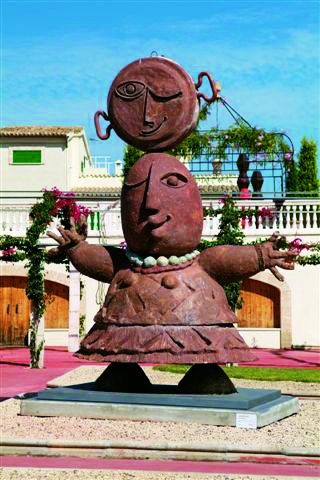Juan Ripollés’ muses
Without rejecting his most obscure periods, especially in the seventies, we focus on the aspect of fullness present in his whole work, and especially on his muses, expression of a colourful and vigorous poetic. This essence reveals a permanent dichotomy between what is monumental and fragile, which has an exact correspondence to the artist’s appearance: apparently slim but very resistant as well as delicate. A significant example of the monumentality of his work are his sculptures; Señora con sombrero (Lady with Hat), 1998, and Las gemelas (The Twins), 1998. From 1996, the dimensions of his bronze works reach sixteen metres, like his Homenanje al libro (Homage to the Book), 2002. It is significant how the artist, with great ease, goes from a five metre sculpture to an identical one of just one metre, without breaking the equilibrium, like in the case of his Tótems (Totems) or Tumbada and Tumbado (Laying), 2008. But the artist takes the challenge even further, making El tumbado de corazón, 2003, or La mujer tumbada (The reclining Woman), 2007, in a very small dimension out of marble and glass respectively. The narrative which exposes women’s moments of pleasure uses big formats that allow the different phases of these scenes to be evoked. The production of this plastic artist has also given works of smaller format. He therefore controls what’s hot and cold, colossal and refined; and even when the work is colossal, it has self-refinement. His Murano glass sculptures are, above all, transparent, fragile and delicate. The Muses preside over Juan Ripollés’ work, actually he doesn’t preach the Genesis of humanity neither of gods, nor divine intervention in creation. However, the metonymy that characterizes them as sources of happiness and knowledge fully belongs to Ripollés. Mneme is a vast territory, deeply enrooted in him. It is the Mediterranean myth, profound and spontaneous emotions, in communion with Mother Nature. It joins Erato in loving embraces and eroticism surfaces. Melete, Aoide and Euterpe inspire him in his workshop going beyond just leaving a mark on his work. Finally Calliope fills his work with a kind of mischievous magic causing visual impact and transmitting vitality. This is, of course, not only valid for muses; it allusively allows us certain references to mythological fauns. A cosmic energy is released. Euterpe the muse, is omnipresent since 1990. Plastic or musical, the artist sets no boundaries to any artistic sphere. He carries out individual portraits of musicians on canvas, or Murano glass sculptures, as well as of groups which amplify rhythm. The plastic artist is marked by several aspects of poetry: boundless fantasy and continuous metamorphosis as in Metamorfosis de la musa del artista (The Metamorphose of the Artist’s Muse), 1983, unbelievable reaction caused by the combination of different unusual spheres (such as anchor/hat, woman/guitar), metonymies, issues in which tenderness comes to surface, colour tones accompanied by harmonious luminosities. One of the difficulties tackling Ripollés’ work is his refusal of codes and categories, as well as his hybridisation of materials and practices. Furthermore, rejection of conventionalism together with crossbreeding gives the whole work coherence. A work full of life and energy, enrooted and connected characters, themes and techniques. His capacity to visualize, from an every day or worn down object, the metamorphosis it will undergo to in its way to poetical world is excellent. The artist simultaneously develops volume, size, proportion, sense of touch, resistance and light. The artist offers a recreational world based on humour and irony. is work presents a wide range of nuances, suggestions, atmospheres, built over interlaced line dualities, over chromatics, ranging from serious to loud, from soft to happy. Anyone can perceive utopia and daily reality, more or less veiled references to culture and other more selective choices. However, baroque vitality, humour and irony.The transfer of internal expression outwardly, refers to a deep cuestioning of man and of the artista himself. In fact, of all these muses, Juan Ripollés’ muse is life itself, a perpetual metamorphosis of fertility and his art as an endless challenge.







